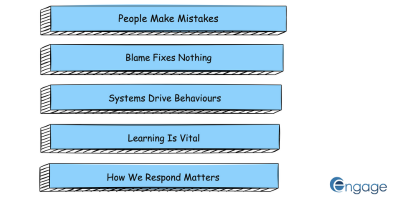Understanding Human and Organisational Performance (HOP) in Health and Safety

In the realm of health and safety, the focus has traditionally been on preventing incidents by enforcing rules, procedures, and controls. However, as industries evolve, so too must our approach to safety. Enter Human and Organisational Performance (HOP), a transformative approach that shifts the focus from blaming individuals for mistakes to understanding how systems, processes, and organisational culture influence human behaviour. HOP offers a holistic perspective that recognizes the complexity of the work environment and the inherent variability of human performance.
So what exactly is HOP?
Human and Organisational Performance (HOP) is a framework that seeks to improve safety and operational excellence by understanding the interactions between people, processes, and the organisational context in which they operate. Instead of viewing errors as failures of individuals, HOP sees them as opportunities to learn and improve the systems in place.
At its core, HOP is based on five key principles:
1. Error is normal: Mistakes are inevitable in complex systems. Instead of trying to eliminate errors, HOP encourages organisations to anticipate them and design systems that can absorb and adapt to these errors without catastrophic consequences.
2. Blame fixes nothing: Blaming individuals for mistakes often overlooks the underlying system flaws that allowed the error to occur. HOP emphasizes understanding the root causes of incidents and learning from them to prevent recurrence.
3. Learning and improving are vital: Continuous learning and improvement are central to HOP. Organisations must create an environment where employees feel safe to report errors and near misses, enabling the organisation to learn and evolve.
4. Context influences behavior: Human behavior is shaped by the environment in which people work. HOP recognizes that workers’ actions are often a response to the pressures, constraints, and complexities of their environment. Understanding this context is key to improving safety.
5. How you respond to failure matters: The way an organisation responds to incidents shapes its safety culture. HOP advocates for a response that focuses on learning and improvement rather than punishment.
The Role of HOP in Health and Safety
HOP plays a crucial role in enhancing health and safety by providing a more comprehensive understanding of how accidents happen and how they can be prevented. Here’s how HOP can be integrated into health and safety practices:
1. Shifting from Blame to Learning
One of the most significant shifts that HOP brings to health and safety is the move away from blaming individuals for errors. Instead, HOP encourages organisations to view errors as learning opportunities. When an incident occurs, the focus is on understanding the factors that contributed to the error, including system design, processes, and organisational culture. This approach fosters a culture of continuous improvement, where safety is seen as a collective responsibility rather than an individual one.
2. Designing Resilient Systems
HOP emphasizes the importance of designing systems that are resilient to human error. This means creating processes that are robust enough to handle mistakes without leading to catastrophic outcomes. For example, in a manufacturing setting, this could involve designing machinery with fail-safes and redundancies that prevent accidents even if an operator makes an error. By designing systems that can adapt to and recover from mistakes, organisations can significantly reduce the likelihood of serious incidents.
3. Enhancing Worker Engagement
In a traditional safety model, workers may feel hesitant to report errors or near misses for fear of punishment. HOP encourages organisations to create an environment where workers feel empowered to share their experiences without fear of retribution. This open communication fosters a culture of trust and collaboration, where workers are more engaged in safety practices and more likely to contribute valuable insights into potential hazards and improvements.
4. Understanding the Work Environment
HOP recognizes that the work environment plays a significant role in shaping human behaviour. Factors such as workload, time pressures, resource availability, and organisational culture all influence how workers perform their tasks. By understanding these contextual factors, organisations can identify potential risks and make informed decisions about how to improve safety. For example, if workers are consistently rushing to meet tight deadlines, this may indicate a need to reevaluate scheduling practices to reduce stress and the likelihood of errors.
5. Building a Just Culture HOP promotes the development of a “just culture” within organisations—a culture that balances accountability with learning. In a just culture, workers are held accountable for their actions, but the organisation also takes responsibility for the systems and processes that may have contributed to the error. This balanced approach ensures that safety improvements are based on a comprehensive understanding of the factors involved, rather than simply assigning blame.
The Future of HOP in Health and Safety
As industries continue to evolve, the integration of HOP into health and safety practices becomes increasingly more important. By embracing the principles of HOP, organisations can move beyond a reactive approach to safety and adopt a proactive, learning-focused strategy that enhances both safety and operational performance.
The future of health and safety lies in our ability to understand and manage the complexities of human behaviour within organisational systems. HOP provides a powerful framework for doing just that—transforming the way we think about safety and creating workplaces where everyone can thrive. To find out how Engage can assist with HOP in your organisation, contact us today.
